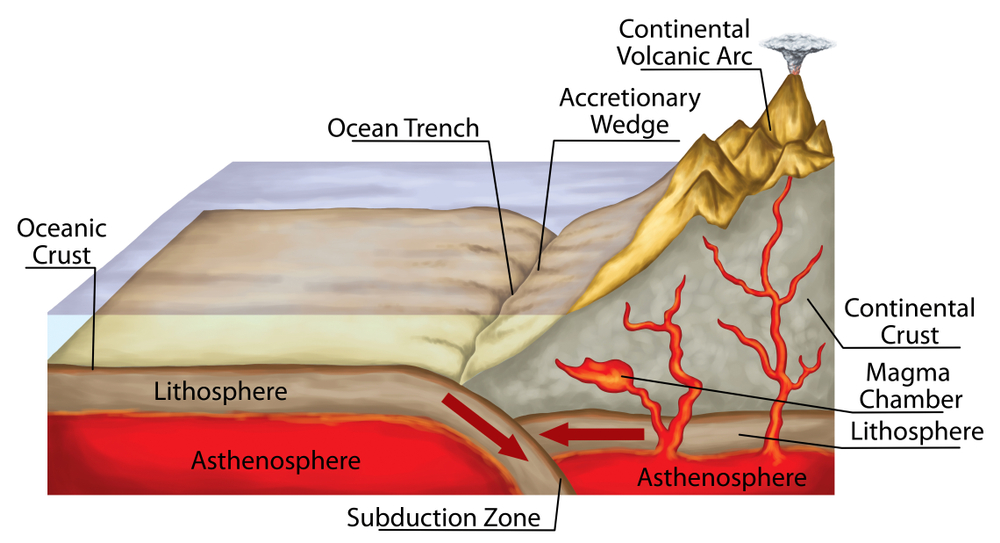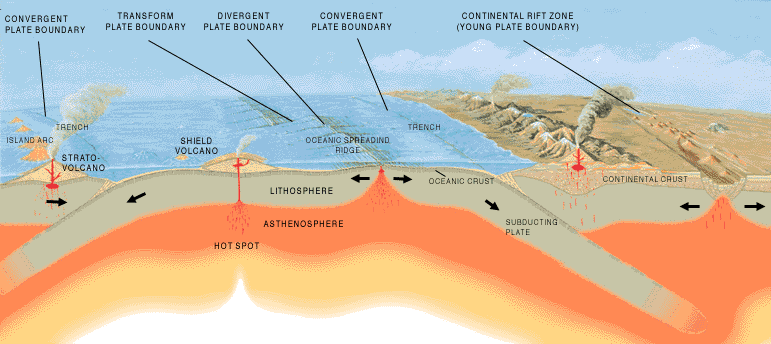

An example of a tectonic plate containing both the oceanic crust and the continental crust is the African plate which consists of the continent and the parts of the floor of the Atlantic and the Indian Ocean. The tectonic plates are made up of lithospheric mantle consisting of two types of crustal material: either the oceanic crust which is found below the water of oceans (made up of silicon and magnesium) or the continental crust (made up of silicon and aluminium) which floats on the water or both. Thus, in order to define tectonic plates or also known as the lithospheric plates, one says that the tectonic plates are the separate and distinct plates made up of lithosphere which ride upon the fluid-like asthenosphere. And a plate here means the fragments of the lithospheric surface of the earth which are different from each other in various properties. The tectonic meaning includes all the large-scale activities such as the volcanic activity that takes place on the lithospheric mantle of the earth. Now, thinking about the topic the first two questions that arise are - what is tectonic and what is plate. This difference is based on the differences in the mechanical properties and the transfer of heat in-between the two layers. The outermost layers of the Earth are divided into two - the lithosphere and asthenosphere. Moving further the plate tectonic theory and the tectonic plates definition are explained below. Also, it has provided an in-depth understanding of the evolution of Earth’s surface and reconstruction of the past of the continents and oceans. The theory provides a uniform understanding of mountain-building processes, volcanoes and earthquakes. The geoscientific community has accepted the plate tectonic theory after obtaining significant proof on the seafloor spreading concept. The plate tectonic theory is built from the concept of the sliding and movement of the continents. Global Tectonics, Blackwell Science, 1996.Plate tectonics is a scientific theory that describes the large-scale movement and the distribution of the plates that make up the earth’s lithosphere. (2003) An updated digital model of plate boundaries, Geochemistry Geophysics Geosystems, 4(3), 1027, doi:10.1029/2001GC000252. This somewhat smaller length requires that Earth's surface area must be consumed at subduction type boundaries at a faster rate than it is created at ocean spreading ridges.īird, P. The total length of subduction type plate boundaries is second in rank to the ocean spreading ridge. Here which the vast majority of new planetary surface area is created as oceanic lithosphere. The plate boundary of greatest total length belongs to the ocean spreading ridge class.

CCB - Continental Convergent Boundary - 23,000 km (8.8%).CTF - Continental Transform Fault 26,100 km (10.0%).CRB - Continental Rift Boundary - 27,500 (10.5%).Plate Boundaries classes ranked in order of length (km) and by relative percent of total plate boundary length: Although the plate boundareies have commonly been compared to seams on a baseball, in reality the pattern is much more elaborate with seams of much greater length and complexity. The total length of Earth's present-day plate boundaies is 260,000 km or some 6.5 times lonnger than the Earth's circumference at its equator. Note that many plates consist of both oceanic and continental lithosphere. In Earth Observer's map we have used the synthesis of Bird (2003) and subdivided these three types into seven classes according to whether the lithosphere that makes up the plates at the plate boundary is continental or oceanic.Ī subduction bcoundary is where oceanic lithosphere belonging a converging plate slides under either continental lithosphere of the adjacent colliding plate or an island arc on the adjacent plate.

Transform boundaries where plate slide past each other and no (or very little) new surface area is created or destroyed.Divergent or rift boundaries where plates separate and new lithosphere is created in the gap to generate planetary surface area.Convergent boundaries where plates collide, one slides beneath the other, and surface area on Earth is consumed.There are three overarching types of plate boundaries: Plate Boundary Types Plate Boundary Types


 0 kommentar(er)
0 kommentar(er)
